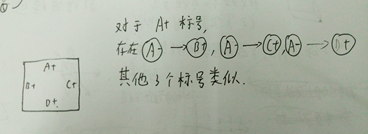原题地址:https://uva.onlinejudge.org/index.php?option=com_onlinejudge&Itemid=9
这题做了挺久,参考了网上一些大神们的代码,有几个点要搞懂。
首先,将题目转化成图论模型。以正方形为边,标号为点,构造有向图。具体构造方法:

对于正方形中的任意一个标号 X,若为 X+ ,则存在 X- 可以到达这个正方形,及 X- 可以到达这个正方形除 X+ 外的任意一点。这样,题目就转化成了一个有向图,而根据题意,要构成无限大的图,只要有向图中存在环路即可,因此可以用拓扑排序做。
还有一个很巧妙的技巧,2*n ^ 1 = 2*n + 1, (2*n + 1) ^ 1 = 2*n, 可以实现 X+ 与 X- 之间的转化。
AC代码:
/* Self-Assembly (UVa 1572) */ #include <iostream> #include <cstring> using namespace std; const int maxn = 52; int a[maxn][maxn]; //存放有向图 int vis[maxn]; //标记遍历 char s[10]; //读取每一个数据 void connect(char x1, char x2, char y1, char y2); //连接两个点 int getID(char c1, char c2); //获得一个点的编号 bool solve(); //检查是否存在环 bool dfs(int u); //找环 int main(){ //freopen("input.txt", "r", stdin); //freopen("output.txt", "w", stdout); int n; while(cin >> n){ getchar(); memset(a, 0, sizeof(a)); memset(vis, 0, sizeof(vis)); while(n--){ scanf("%s", s); //以正方形为边,标号看成点,建立有向图 for(int i=0; i<4; i++) //与正方形其中一个标号 a 可以连接的标号 b, 连接除 a 以外的其他标号 for(int j=0; j<4; j++) if(i != j) connect(s[2*i], s[2*i+1], s[2*j], s[2*j+1]); } if(solve()) cout << "unbounded" << endl; else cout << "bounded" << endl; } } void connect(char x1, char x2, char y1, char y2){ if(x1 == '0' || y1 == '0') // 00 不可以和任何标号连接 return ; int num1 = getID(x1, x2) ^ 1; //与 x 这个点相连的标号的编号。 int num2 = getID(y1, y2); a[num1][num2] = 1; } int getID(char c1, char c2){ return (c1 - 'A')*2 + (c2 == '+' ? 1 : 0); } bool solve(){ for(int i=0; i<maxn; i++){ if(dfs(i)) return true; } return false; } bool dfs(int u){ vis[u] = -1; //进入栈 for(int v=0; v<maxn; v++){ if(a[u][v] == 1){ if(vis[v] == -1) return true; else if(vis[v] == 0) { if(dfs(v)) return true; } } } vis[u] = 1; //出栈 return false; }